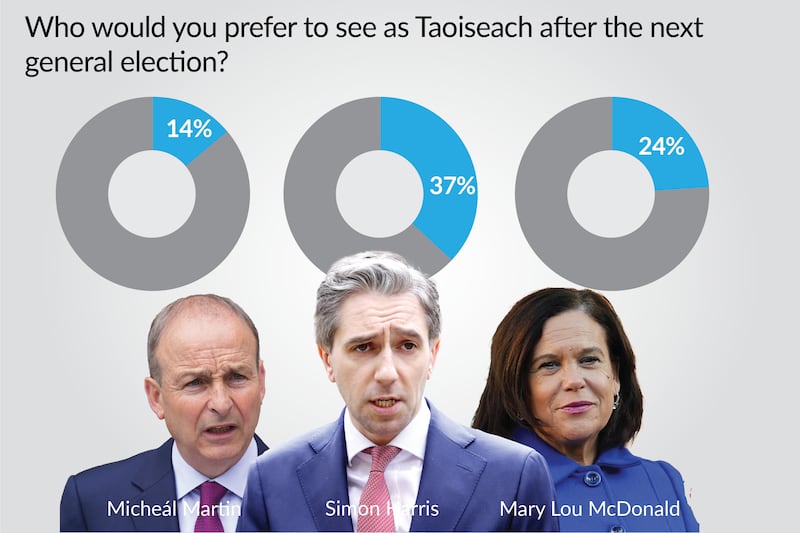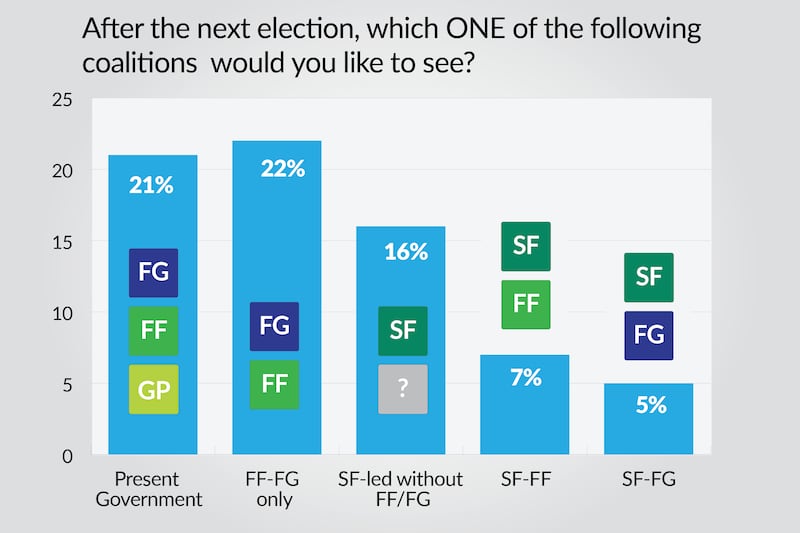Part two of Simon Harris’s romp through the opinion polls.
Today Harris – after seeing his party’s support jump and his own approval ratings surge in data reported on Thursday – finds himself the top choice for taoiseach.
Asked who they would like to see as taoiseach after the next election, 37 per cent opted for Harris, almost a quarter (24 per cent) for Sinn Féin leader Mary Lou McDonald and just 14 per cent for Tánaiste and Fianna Fáil leader Micheál Martin.
Martin’s low rating is a surprise – he enjoyed strong approval ratings as taoiseach, even among supporters of other parties. But here even a substantial minority of Fianna Fáil voters (38 per cent of them) plump for Harris. As we saw from his high approval ratings earlier in the week, people have been impressed by his high-octane activity and relentless media profile since becoming Taoiseach in April.
READ MORE

Martin’s style is more low-key and considered. The contrast between the two will, inevitably, firm up into rivalry during the forthcoming election campaign.
The timing of that election campaign is a topic of incessant speculation in political circles right now. Will it be November or next year, February or March?
The Taoiseach and his fellow Coalition leaders insist that their position hasn’t changed; they intend to go until the end of the Government’s term next year. But most people in and around politics think their position will change because that seems to be so obviously in their interests.
That expectation has heightened in Fine Gael since the first poll results this week; it has, however, eased in some parts of Fianna Fáil. Some in the party think maybe next year isn’t such a bad idea now; it might allow them time to close the eight-point gap with their Government partners. The diverging political interests of its main components will become more evident the longer the Government goes on.
The public does not have a decisive view on when that election should be: 36 per cent say wait until next year, 35 per cent say go this year and 27 per cent say it makes no difference. Support for the 2025 option is strongest among the Government parties’ voters.
Whenever that election takes place, however, voters have a clear preference for the government they want to see in office after it: one comprising Fine Gael and Fianna Fáil.
More than a fifth of voters (21 per cent) want to see a continuation of the present Government; another 22 per cent want to see a coalition of Fianna Fáil-Fine Gael alone. A government led by Sinn Féin without either Fine Gael or Fianna Fáil is the choice of 16 per cent, while a Sinn Féin-Fianna Fáil coalition (7 per cent) and a Sinn Féin-Fine Gael coalition (5 per cent) are more marginal choices.

Fourteen per cent of voters favoured none of the above options, while 15 per cent expressed no opinion.
Sinn Féin has the highest negatives; 37 per cent of voters do not want to see the party in government. The Greens are next on 26 per cent, Fine Gael on 18, Fianna Fáil on 19.
Parse all this for a minute: of those who express a preference on the question, a clear majority (43 per cent of the total) want to see FF and FG back in government together. A government that contains Sinn Féin in any role is the choice of 28 per cent, with the greater part of those wanting a left-led government headed by McDonald. In anyone’s language, that is a clear lead.
[ The Irish Times view on Fine Gael’s poll surge: a big jump for Simon HarrisOpens in new window ]
This finding chimes with the results when voters are asked about their attitude to change – often the great trope of modern political campaigns. There is a sizeable constituency for radical change – 38 per cent favour it. But a clear majority – 51 per cent – say they want moderate change. And a further 8 per cent are wary of any change at all.
But there was a discordant note when another change-related question was asked. Just more than a quarter of voters (27 per cent) agreed that the “Government has already made progress in important areas and deserves to be allowed get on with the job”; a similar proportion (26 per cent) said that it is “already time for radical change of direction for the country”. But four out of 10 voters (40 per cent) said that the Government “is not making enough progress in important areas and it is time for a change”.
How to reconcile this with the popularity of Harris and desire for the current Government to return? Is it possible that some voters are seeing Harris as a change candidate? After 13 years of Fine Gael in government, that would be quite a coup.
One final point about the general political landscape is worth making. There have been two chief political trends this year – the rise of Fine Gael and the fall of Sinn Féin.
But the most enduring feature of Irish politics in the past decade and a half has been its volatility.
Voter loyalty is low; minds change frequently; lots of votes are up for grabs. It would be foolish to think that kinetic unpredictability is at an end. Politics is not static; it is ever a moving picture.










